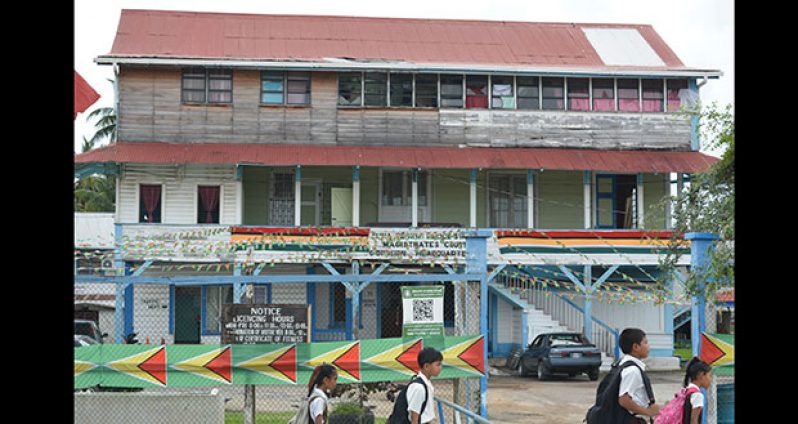A THRIVING commercial centre is located in the Cinderella County of Essequibo. Surrounded by, and including communities with peaceful and happy people, it is the first town in Region Two, and it got its name through an unfortunate circumstance.

Anna Regina was originally a Dutch plantation that was bought over by the British planters soon after Britain took over Essequibo in the early 1800s. Guyana Chronicle was unable to identify the Dutch name for the plantation, but was able to determine that the plantation was a privileged zone, and was owned by an Englishman who had two beautiful daughters: Anna and Regina.
From reports, Anna and Regina were fond of swimming, and would, very early in the morning, regularly indulge themselves in their favourite pastime in a canal located in their clean, scenic plantation. The girls were said to be aged eight and 13, but this newspaper was unable to find out which of the girls was 8 and which was 13. However, from accounts, in brilliant sunshine at about 08:30 hrs one day, Anna and Regina set out to swim unsupervised, and all was going well until one of the girls began to sink below the surface, even as she struggled violently to remain buoyant.
It is not clear whether Anna or Regina was the one going down, but on seeing the ghastly sight, the sister who was in the safe rushed to help the one in distress. However, being unaware of how to help a drowning person, her valiant effort proved to be not only an act in vain, but one that engineered a double-tragedy.

When a person is drowning, several techniques can be employed to facilitate safe rescue. One: the drowning person can be provided access to a lifeline to enable a pull to safety. Two: the drowning person can be knocked unconscious so that he/she can be transported to safety without any great danger to the rescuer. Three: the drowning person can be provided with a floating device. It is not advisable that a rescuer should take on this mission believing that he/she can take a struggling person to safety, because ‘the grip of death’ from a drowning person can be overwhelming.
This is most likely what happened when one of the sisters tried to rescue the other and ended up being swallowed up by the plantation canal.
DARK HISTORY

But the tragedy also told of the dark side of the trenchant racism of the day. Black plantation workers were not allowed to have lands in white areas. Thus the plantation was a privileged zone, and probably the nearest neighbours were Africans. No doubt, Anna and Regina would have screamed for help, but their screams were not loud enough to alert their parents or their closest neighbours.
The tragedy reportedly occurred sometime between 1810 and 1815, and the sisters were interred at a location close to where the Anna Regina Primary School now stands.
In death, their memory lived on. In fact, it gave birth to the renaming of the plantation in which they drowned to Anna Regina.
From a plantation, Anna Regina was, like the mythical Cinderella, transformed into a town in 1990 by then President Desmond Hoyte.

Eighteen (18) villages were merged, and the population of the township has since grown from some 7,000 to about 16,000 today.
From the Dutch to the British to Independent Guyana, Anna Regina has grown with confidence with each passing year.
The British took over Essequibo with 34 sugar mills, but today all have disappeared. Rice factories have been built over most of them, as is evident with the rice factory at Hampton Court and the ones at Anna Regina, Land of Plenty, Aurora, Johanna Cecelia, and Golden Fleece, all located in the township of Anna Regina.

DEVELOPMENT CENTRE
Prior to 1980, Anna Regina was the gateway to the Pomeroon River, and was a major centre of development on the Essequibo Coast. There was no road from Bounty Hall to Charity, and the Pomeroon River had to be accessed through Lake Tapakuma. The Pomeroon was then home to the Court Hall and a police station.
Anna Regina was supervised by Suddie, then the main administrative centre on the Essequibo Coast; but with the promulgation of the 1980 Constitution, which provides for a regional system of government, that situation changed.
The town is also home to a number of historical sites, notably the 1972 Monument at Devonshire Castle which commemorates the first East Indian sugar workers who were killed while protesting for better working conditions; the 1834 Monument (Damon Statue) to the slave leader who was caught and hanged in Georgetown; and the Anna Regina High Bridge, built in 1816 to allow punts from the then sugar factory at Anna Regina to transport sugar, molasses and rum to Port Georgetown for export to Europe.
The Anna Regina Police Station is more than 100 years old, while the Anglican Church in the town is 150 years old.
The town is also gateway to three Amerindian settlements, namely St Deny’s, Lake Mainstay/Whyaka, and Capoey.
A land development scheme opened in 1957 took firm root in 1960. Soon after, secondary schools, a market and agricultural institutions were built; and later banks, sprawling supermarkets and fuel stations followed.
Anna Regina, like the region in which it is located (Region Two), is traditionally a People’s Progressive Party stronghold. At the last Local Government Elections, which were held for the first time in 22 years, the PPP regained administrative control of the township of Anna Regina and the region with relative ease.



.jpg)











